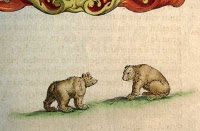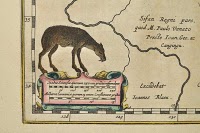Written by Erin Hammeke, Conservator for Special Collections
 I just returned from two fantastic professional development opportunities. First, I attended the Ligatus Summer School class on the History of European Bookbinding 1500-1800, held this year at the Herzog August Bibliothek in Wolfenbüttel, Germany.
I just returned from two fantastic professional development opportunities. First, I attended the Ligatus Summer School class on the History of European Bookbinding 1500-1800, held this year at the Herzog August Bibliothek in Wolfenbüttel, Germany.
Drawing from the instructor Nicholas Pickwoad’s research and using examples from the library’s collection, the class examined how changes in the style and structure of book bindings produced during this period can illustrate the effects of changing pressures and developments in the book trade and in the printing and bookbinding industries at the time.
The class will allow me and my fellow conservators to better contextualize the bindings we comes across during the course of our work as conservators as well as enable us to identify, document, and preserve critical evidence during treatment.
 I then went to a workshop taught by Renate Mesmer, Assistant Head of Conservation at the Folger Shakespeare Library in Washington, D.C. The workshop Tips & Tricks for Book and Paper Conservation was held in the bookbinding studio at North Bennet Street School in Boston.
I then went to a workshop taught by Renate Mesmer, Assistant Head of Conservation at the Folger Shakespeare Library in Washington, D.C. The workshop Tips & Tricks for Book and Paper Conservation was held in the bookbinding studio at North Bennet Street School in Boston.
It was packed full of practical techniques and handy tricks that Ms. Mesmer has amassed during her 30+ years as a bookbinder, conservator and educator. The tips ranged from pulp-filling paper losses, performing corner and leather repairs, and to creating a new flexible leather binding.
I am really looking forward to sharing these techniques with my colleagues in Conservation and to putting them to good use in my treatments.
 As you loyal readers already know Boxing Day comes around every month, in fact it now comes around twice a month because we have so much coming into the collections that need enclosures. We crank out the work on Boxing Day but we also get to stop ever so briefly to take a closer look at some of the materials.
As you loyal readers already know Boxing Day comes around every month, in fact it now comes around twice a month because we have so much coming into the collections that need enclosures. We crank out the work on Boxing Day but we also get to stop ever so briefly to take a closer look at some of the materials. What really struck me were the cigarette ads inserted into the middle of the books. I wasn’t reading pulp fiction in the early 1970’s as I was too young to do so. I wonder, were cigarette ads put into a lot of pulp fiction titles? or was this a targeted advertising campaign? I’d be interested to know more if you know anything about this title, publisher or 1970’s pulp fiction in general.
What really struck me were the cigarette ads inserted into the middle of the books. I wasn’t reading pulp fiction in the early 1970’s as I was too young to do so. I wonder, were cigarette ads put into a lot of pulp fiction titles? or was this a targeted advertising campaign? I’d be interested to know more if you know anything about this title, publisher or 1970’s pulp fiction in general.












